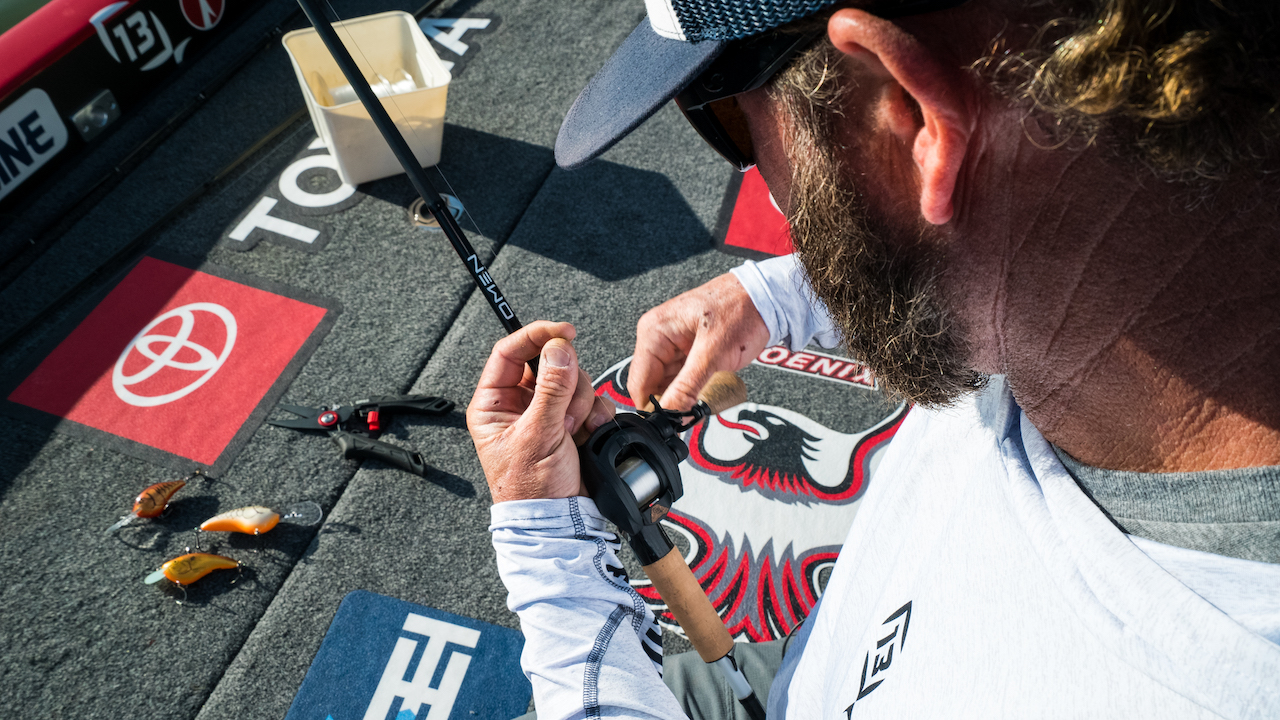Gerald Swindle relies on crankbaits to find and trigger prespawn bass on rivers and reservoirs. We connected with him on the Tennessee River to learn how and where he fishes crankbaits during late winter’s high and dirty water, as bass start thinking about the prespawn. *Additional product links at the bottom.
FEATURED CRANKBAITS
- Rapala OG Tiny 4 Crankbait, color – Chartreuse Rootbeer Crawdad
- Rapala Dives-To Series Crankbaits, DT 8, color – Demon
- Rapala Ott’s Garage Slim 06 Crankbait
- Rapala Shad Rap
Swindle shares 5 tips that run the gamut from how and where bass position, why finesse balsa crankbaits are the best lures to start with, and how to fish the baits to get the most bites:
GMAN’s 5 crankbait tips for late winter and early spring bass:
- Target current breaks. Late winter and early spring see an uptick in water levels and a corresponding dirtying of the water. Current on rising water helps position bass in predictable spots such as in the eddies behind boulders, slack water behind points, and other current deflection.
- Use finesse balsa crankbaits. Swindle has better success starting with smaller crankbaits with a subtler action. He usually begins by targeting shallow water with a balsa flat-sided crankbait, making sure to contact cover throughout the retrieve. The best baits are fairly neutrally buoyant or a slow rise, keeping them in the strike zone longer — similar to jerkbaits, this can be key to getting bites in cold water.
- Make constant bottom contact. Current-influenced bass hug tight to the bottom and any key cover elements. Cold, dirty water keeps the strike window narrow, so make sure to get your bait where it counts and keep it there. As mentioned above, crankbaits with neutrally buoyant or slow rise characteristics help keep the lure where it counts. Incorporate pauses pulls and interact with the structure and cover as the bait collides and careens over it.
- Have several crankbaits at the ready. Experiment with running depths to find different populations of fish. Swindle follows up a shallow cranking pass with a deeper diver to work adjacent edges and flats. An 8- to 10-foot diver works a highly productive depth zone and allows you to maintain easy bottom contact longer than a 4- to 6-foot diving bait. Bottom line, have subtle shallow and mid-depth baits at the ready.
- Use a light rod setup. Skin-hooking bass is common in cold water, so Swindle opts for a light power rod with a slower taper to combat tearing hooks out. Straight fluorocarbon in the 10- to 12-pound test range is ideal for hitting max running depth.
ROD SETUP
- ROD – 13 Fishing Omen Black 3 Casting Rod, 6’7″ Medium
- REEL – 13 Fishing Concept A2, 5.6:1
- LINE – Sunline Shooter Fluorocarbon, 10-pound
ELECTRONICS
- BOW GRAPH 1 – Humminbird SOLIX 12 CHIRP MEGA SI+ G3N
- BOW GRAPH 2 – Humminbird HELIX 12 CHIRP MEGA SI+ G4N
- LIVE SONAR – Garmin LVS 32 LiveScope + ECHOMAP Ultra 106sv
- 360 SONAR – Humminbird MEGA 360 Imaging for Ultrex
- TROLLING MOTOR – Minn Kota Ultrex
OTHER GEAR
- SUNGLASSES – Costa Del Mar Reefton
- SWEATSHIRT – Rapala Fleece Pullover Hoodie
- T-H Marine Troll Jacket
- T-H Marine Chill Trax Minn Kota Ultrex












